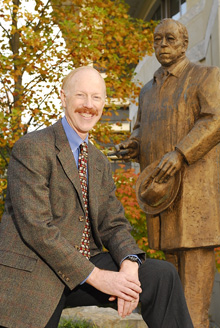Campus News
May 3, 2010
A growing library's search for space

Rick Luce
In an ideal world, the Robert W. Woodruff Library would have room to accommodate all of the library’s holdings in the heart of campus. In reality, however, the library maxed out its space decades ago and must store low-use materials off-site. By Aug. 31, the library needs to free up an additional 20,000 linear feet of Stack Tower space — the equivalent of one floor — to centralize the world-renowned collections in the Manuscript, Archives, and Rare Book Library (MARBL). Emory Report interviewed Rick Luce, vice provost and director of libraries, for details on the proposed changes.
Emory Report: Why is Woodruff Library dedicating space to MARBL now?
Rick Luce: We exceeded physical capacity to support storing all library materials on campus decades ago and have since stored low-use materials off-site. Nearly every research library in North America now uses remote storage facilities.
Annually, we acquire about 95,000 new volumes, which puts further pressure on the library to create shelf space. We are rapidly approaching a one book in and one book out to storage trade-off. We have forestalled reaching full capacity via the conversion to compact shelving on floors four through seven. Only two floors now remain to be converted; each converted floor defers complete saturation for about 24 to 30 months.
Further exacerbating this reality is the need to centralize and protect the library’s most valuable assets, one-of-a-kind MARBL special collections that are scattered and stored in less than optimum conditions. We already dedicate tower floors 10 and 11 to MARBL collections, as well as leasing off-site storage space. We want to bring the MARBL collections together in one location.
ER: What are the criteria for selecting materials to go off-site?
Luce: To identify which materials will be sent to storage, we are employing the methodology used by the library for the past three years. As a first step, we identify bound journal titles that are either low-use and/or are available in an electronic format and then we identify books that have not circulated and were published before a given date. In addition, a determination will be made regarding life sciences materials to be moved to the Woodruff Health Sciences Center Library or to storage. In the future, we will integrate the health sciences and life sciences collections and services together in one library.
ER: How have faculty and other users been involved in this dialogue?
Luce: The criteria used to determine what will move to storage was discussed during briefings on three occasions with the Library Policy Committee, and then communicated to faculty via subject liaisons and during a town hall meeting on March 25. After considering faculty feedback from the meeting, we modified our criteria to determine what should be moved to storage. A coffee and Q&A was held with College faculty on April 21.
ER: How will faculty and other users be able to access materials in storage?
Luce: Library users may request that items in storage be delivered to the library. This practice is currently in operation and will continue. Requests can be placed online through the EUCLID system. Requested books and journal volumes usually take about one business day to arrive at the Woodruff Library circulation desk. Scans of articles from journals kept in the storage library, located in the 1762 Clifton Road complex, are generally delivered to the requestor’s desktop in one business day.
